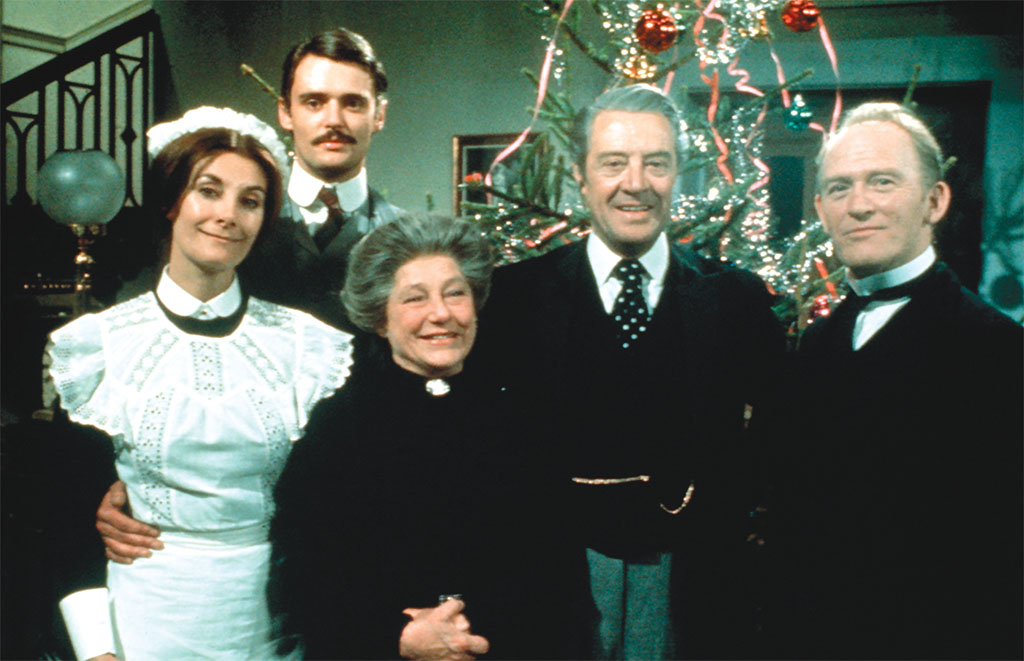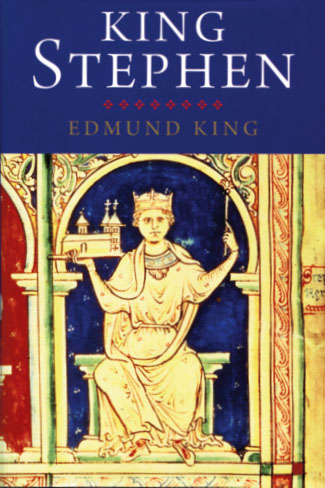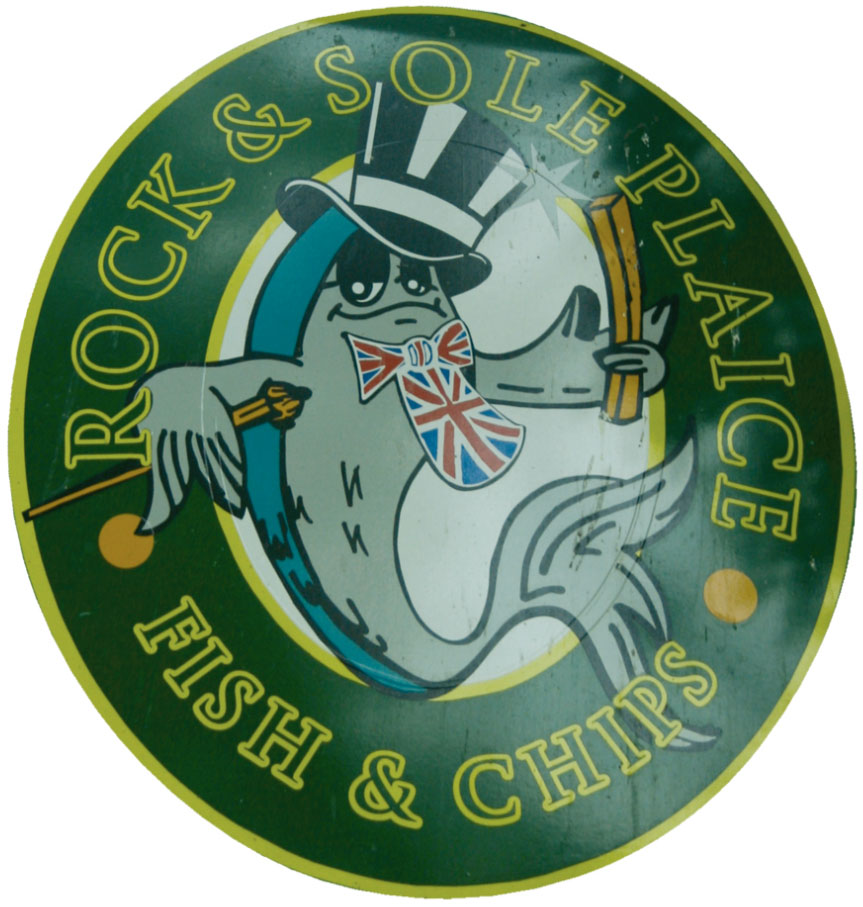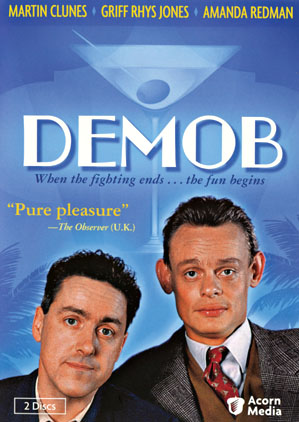
Upstairs and Downstairs at 165 Eaton Place
DVD
Upstairs, Downstairs: The Complete Series, 40th Anniversary Edition, 21-disc boxed set, Acorn Media, Silver Spring, Md., 68 episodes, app. 57 hours, &doller;199.99
[caption id="BeyondtheBookshelf_img1" align="aligncenter" width="249"]

THERE ARE FEW THINGS BETTER than curling up with a good DVD series at the end of a long day, and there are few shows more worth watching than the original, delicious Upstairs Downstairs. Watched by more than a billion people worldwide, never out of Britain’s top 10, and winner of nine Emmys, a Golden Globe and a Peabody Award, it has recently been released by Acorn in a complete 21-disc set. Because of a technician’s strike, five of the early episodes were filmed in black and white and have never before been seen in the United States. They are now included in this beautifully boxed collection along with episode commentaries, an anniversary retrospective and interviews with the stars, creator and composer.
The series engages us in the life of the “upstairs” aristocratic Bellamys and their “downstairs” loyal servants between 1903 and 1930. It opens up into the Edwardian morning room of the Bellamys and invites us into a world that, because of the class system of the time and because that world long ago ceased to exist, most people would never have the pleasure to experience.
Mrs. Bellamy is elegant in her composure and her serene self-confidence. She spends her days managing the household servants, making and receiving calls and accompanying her husband, Sir Richard Bellamy, to society events. Daughter of a prime minister, it is Mrs. Bellamy’s money and influence that have made her husband’s political ambitions possible. As a parson’s son, Mr. Bellamy was infused with a code of ethics that expresses itself in how he casts his vote in parliament and how he leads his household. With the help of the loyal butler, Mr. Hudson, 165 Eaton Place is flawlessly ordered, creating a perfectly unrippled appearance to the outside world.
The evolution of fashions, the gorgeous townhouse, the exquisite display of manners, and the promise that any difficulties are easily solved with a cup of tea, are among the reasons why the series is so compelling. Make no mistake, however, there are currents under the surface. The Edwardian era and its aftermath were a time of incredible change, and the series takes an undaunted look at history.
Despite all the distinctions and differences in the classes, events such as the women’s suffrage movement, the Titanic disaster, World War I and the Wall Street Crash are expressed equally in the lives of the characters at 165 Eaton Place. These changes contribute to illicit affairs, divorce, grief, homosexuality, suicide, prejudice, social responsibility, freedom and the search for meaning in life. The Bellamy children struggle to find their place in a newly liberated world that often opposes their parents demand for tradition. The servants, meanwhile, debate the seductive idea of a home and money of one’s own with the fear of giving up the safety they’ve known under their employers. Through it all, Mr. Hudson, the butler, and Mrs. Bridges, the cook, hang on to a rigid belief in the old way of things that is at once both inspiring and ridiculous. The show provides much to ponder, and curiosity about how the characters will adjust to a changing world is yet another quality that makes this series so gripping.
[caption id="BeyondtheBookshelf_img2" align="aligncenter" width="1024"]

COURTESY OF ACORN MEDIA
Upstairs, Downstairs was created by two out-of-work actresses, Jean Marsh and Eileen Atkins—both of whose parents had been in domestic service. Jean Marsh played a major role in the series, that of head house parlor maid, Rose, and she alone returned in the new Upstairs, Downstairs Downstairs series that debuted on PBS in March. The original series was aired in Britain from 1971 to 1975, and in America from 1974 to 1977.
One of the surprisingly endearing qualities of film produced in this time is the limited number of camera angles and editing special effects. There’s little distance between the viewer, the actors and the story, which leads to an intimacy not easily experienced in today’s cinema. So, pour yourself a nice cup of tea and experience history through the characters both upstairs and downstairs at 165 Eaton Place, Belgravia.
—Lorraine Moffa
BOOKS
King Stephen by Edmund King, Yale University Press, New Haven, 384 pages, hardcover, &doller;55.
[caption id="BeyondtheBookshelf_img3" align="alignright" width="325"]

325
Always Fighting for the Throne
FOR ALMOST 20 YEARS, civil war tore apart the fabric of England in the 12th century. On the death of Henry I in 1135, his nephew Stephen, Count of Mortain, was elected to the Anglo-Norman throne of his grandfather,William the Conqueror, by the English barons. King Henry I, however, had a daughter, Matilda, who contested the crown, and, as Empress Matilda (or Maud), spent the next two decades pursuing the throne by force of arms. The violent, unstable times became known simply as The Anarchy.
Respected medieval historian Edmund King unpacks this relatively little known era in King Stephen, the latest addition to Yale’s English Monarchs series. While the well-intentioned and generous King Stephen holds center stage in the drama of his times, this narrative is less about him as a man than about the generation of shifting alliances, civil war, failed diplomacy—in essence the human impact of a generation of internecine strife among the royal progeny of William the Conqueror.
Detailed histories of England’s 12th century are relatively sparse on the ground. King Stephen is a valuable addition to the historiography of that early medieval era. While the relatively rich and surpassingly powerful dominate the politics of the era, however, a portrait emerges of just how difficult life was for everyone in that age. Though King’s book is a very readable volume, it is detailed history, with dense narrative and lots of annotation. This work is highly recommended, but it’s not light reading.
Fancy a Bite to Eat?
FROM EARL’S COURT to Canary Wharf, restaurants by the thousands of every description, price range and ethnic cuisine contribute to the colorful mosaic of London life. As we know, restaurants often come and go quickly. But some restaurants just come.
In practice, most of us visiting London just don’t have the time or energy at the end of the day to cross town seeking out particular places to eat. For those with any culinary interest, however, here are 40 truly iconic restaurants that have been around for years and are well worth a little extra effort to experience.
While some of them, yes, are surpassingly expensive, certainly many would fit into the budget of most visitors. For instance, The Rock&Sole Plaice on Endell Street has been serving up some of London’s best fish and chips since 1871. Over in Spitalfields, people flock to the Beigel Bake on Brick Lane, where proper bagels as well as an overwhelming variety of breads and pastries pour from the ovens in a never ending stream—open 24 hours a day. Afternoon tea, meanwhile, is served with legendary panache and elegance at Fortnum&Mason, while Soho’s Bar Italia has been serving up great inexpensive comfort food with Italian flair for more than 60 years.
More well known, perhaps, are the London “classics”: Simpson’s-in-the-Strand, for its roast beef carved off the trolley; Rules, opened in 1798 and still serving up such British fare as game and pies; The Criterion at Piccadilly Circus, where it’s said Arthur Conan Doyle was dining when he dreamed up the characters of Holmes and Watson. Yes, the great hotel dining rooms are deservedly here as well: Claridge’s, Connaught, The Ritz, The Savoy are included; so, too, are The Punjab (long a British Heritage favorite, of course) and Veeraswamy for those of us who love the spice and verve of the Indian subcontinent. For a more basic steak and fries, perhaps the best in the city can be found at Rowley’s on Jermyn Street. One could go mouth-wateringly on and on.
BOOKS
London’s Classic Restaurants: A Guide to London’s Iconic Restaurants and Eateries by Cara Frost-Sharratt, Interlink Books, Northampton, Mass., 144 pages, softcover, &doller;17.95.
[caption id="BeyondtheBookshelf_img4" align="alignright" width="248"]

London’s Classic Restaurants is a lavishly illustrated, charmingly written introduction to the enduring classic institutions on the London restaurant scene. Forget all the guidebooks. If you are looking for a dining experience or two to add to your memories of London, then look no farther than the archetypal eateries described here. Besides, for anyone with an interest in the delights of gastronomy, this is just a fun read.
[caption id="BeyondtheBookshelf_img5" align="alignright" width="863"]

DANA HUNTLEY
Mon Plaisir for Gallic Gastronomy
[caption id="BeyondtheBookshelf_img6" align="aligncenter" width="657"]

DANA HUNTLEY
RESTAURANT
Mon Plaisir 19-21 Monmouth Street, Covent Garden www.monplaisir.co.uk
THE FRENCH TRICOLOR flies over the entrance to Mon Plaisir. Inside, the décor and ambience evoke the elegant simplicity of a Parisian café or provincial bistro. Little has apparently changed since Mon Plaisir opened near Seven Dials as the first French restaurant in London.
Unsurprisingly, the heart and soul of its menu for three generations has been the recognizable classics of French cuisine, dishes like coq au vin, coquilles St. Jaques, terrine de foie gras and steak tartare. Those with a more adventurous palette find delectable such modern French offerings as pigs trotter fritters stuffed with foie gras and langoustines. Make no mistake, though, whether your choice is cassoulette d’escargots or something as simple as baked haddock or gratinee a l’oignon, the food will be invariably fresh and flawlessly prepared.
While there are arrays of tempting sweet offerings for “afters,” the star of the menu for many is one of the best cheeseboards in London. At any given time, the board holds a choice of 25 different cheeses, brought back each week from France. Choose any five for your plate, but don’t be overwhelmed by the selection. Your server will be happy to identify each cheese and describe its characteristics. Unforgettable.
Mon Plaisir is not the place to grab a quick bite. Even luncheon will have a tendency to stretch along the afternoon. For a Gallic dining adventure in London, however, Mon Plaisir has been hard to beat since the ’40s. Little wonder the famous eatery earns its entry in Classic London Restaurants. If you stick with the modest prix fixe menu at lunch and dinner, l’addition will be reasonable. Dance too deeply into the a la carte menu and add a bottle or two of fine Muscadet or Côte du Rhone, however, and the experience is not for the faint of pocketbook.
Sometimes Peace is Tougher Than War
LIFE AFTER WAR is never easy. Deasy and Dobson had a “good war.” A couple of affable song-and-dance men, they spent their World War II years entertaining the troops with bawdy routines and music hall schtick. All good things come to an end, however, and with war over, Ian Deasy and Dick Dobson are demobbed back into civilian life.
Griff Rhys Jones and Martin Clunes star as the entertaining duo, who find it difficult to adjust to the calm routines of peacetime London. Whatever it might cost, and the cost is high, they are irresistably drawn back to the stagelights. Time moves on, however, and entertainment tastes have changed. The patter songs, barracks ballads and double entendres that were a treat to battle-weary Tommies don’t quite fit the bill in post-war England. The act and the men have some adjustments to make of their own.
DVD
Demob
2-disc set, Acorn Media, Silver Spring, Md., 6 episodes, app. 300 minutes, &doller;39.99
[caption id="BeyondtheBookshelf_img7" align="alignright" width="299"]

Demob is a wonderful six-episode story—human and humorous, painful, pathetic and ultimately very satisfying. As it is in life, the choices Deasy and Dobson make reverberate in the lives of others, of course—the wife who waited patiently, a bewildered son, erstwhile friends and the flotsam and jetsam of life they trip over along the way.
The backdrop to the story, of course, is post-war Britain: the bombed-out buildings, grim and shabby housing, crippling food rationing, painful memories and a society that just wants it all to get better. The writing and cinematography capture it all.
This is unmistakably a comic series, but it is difficult to define. While the story doesn’t reach the dark negativity of “black comedy,” it is by no means “light.”
It’s hard to find any of the characters in Demob likeable, let alone admirable, but then, we do not live in their moccasins or in their times. They do grow on us as the story goes on, and, in the end, Deasy and Dobson find what an entire generation longed for throughout the war—peace.
Thought-provoking and bittersweet.





Comments